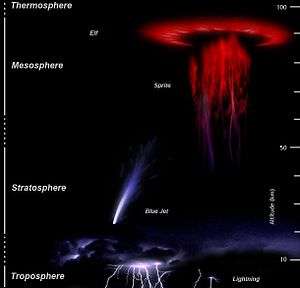Aeronomy
Aeronomy is the meteorological science of the upper region of the Earth's or other planetary atmospheres, which relates to the atmospheric motions, its chemical composition and properties, and the reaction to it from the environment from space.[1] The term aeronomy was introduced[2] by Sydney Chapman in a Letter to the Editor of Nature entitled Some Thoughts on Nomenclature in 1946.[3] Studies within the subject also investigates the causes of dissociation or ionization processes.[4]
Today the term also includes the science of the corresponding regions of the atmospheres of other planets. Aeronomy is a branch of atmospheric physics. Research in aeronomy requires access to balloons, satellites, and sounding rockets which provide valuable data about this region of the atmosphere. Atmospheric tides dominate the dynamics of the mesosphere and lower thermosphere, essential to understanding the atmosphere as a whole. Other phenomena studied are upper-atmospheric lightning discharges, such as red sprites, sprite halos or blue jets.
Atmospheric tides
Atmospheric tides are global-scale periodic oscillations of the atmosphere. In many ways they are analogous to ocean tides. Atmospheric tides form an important mechanism for transporting energy input into the lower atmosphere from the upper atmosphere, while dominating the dynamics of the mesosphere and lower thermosphere. Therefore, learning about atmospheric tides is essential in understanding the atmosphere as a whole. Modeling and observations of atmospheric tides are needed in order to monitor and predict changes in the Earth's atmosphere.[5]
Upper-atmospheric lightning

Upper-atmospheric lightning or upper-atmospheric discharge are terms sometimes used by researchers to refer to a family of electrical-breakdown phenomena that occur well above the altitudes of normal lightning. The preferred current usage is transient luminous events (TLEs) to refer to the various types of electrical-discharge phenomena induced in the upper atmosphere by tropospheric lightning. TLEs include red sprites, sprite halos, blue jets, and elves.[6]
See also
References
- ↑ Brasseur, Guy (1984). Aeronomy of the Middle Atmosphere : Chemistry and Physics of the Stratosphere and Mesosphere. Springer. pp. xi. ISBN 978-94-009-6403-7.
- ↑ Nagy, Andrew F.; Balogh, André; Thomas E. Cravens; Mendillo, Michael; Mueller-Woodarg, Ingo (2008). Comparative Aeronomy. Springer. pp. 1–2. ISBN 978-0-387-87824-9.
- ↑ Sydney Chapman, "Some Thoughts on Nomenclature," Nature 157, (1946): 405. Available on-line at: Nature.
- ↑ Chapman, Sydney (1960). The Thermosphere - the Earth's Outermost Atmosphere. Physics of the Upper Atmosphere. Academic Press. p. 4. ISBN 978-0-12-582050-9.
- ↑ Volland, H., "Atmospheric Tidal and Planetary Waves", Kluwer Publ., Dordrecht, 1988
- ↑ Earle R. Williams (November 2001) "Sprites, elves, and glow discharge tubes," Physics Today, 54 (11) : 41-47. Available on-line at: Physics Today.